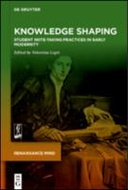Explore

How can we portray the history of Renaissance knowledge production through the eyes of the students? Their university notebooks contained a variety of works, fragments of them, sentences, or simple words. To date, studies on these materials have only concentrated on a few individual works within the collections, neglecting the strategy by which texts and textual fragments were selected and the logic through which the notebooks were organized. The eight chapters that make up this volume explore students' note-taking practices behind the creation of their notebooks from three different angles. The first considers annotation activities in relation to their study area to answer the question of how university disciplines were able to influence both the content and structure of their notebooks. The volume's second area of research focuses on the student's curiosity and choices by considering them expressions of a self-learning practice not necessarily linked to a discipline of study or instructions from teaching. The last part of the volume moves away from the student’s desk to consider instructions on note-taking methods that students could receive from manuals of various kinds. ; How can we portray the history of Renaissance knowledge production through the eyes of the students? Their university notebooks contained a variety of works, fragments of them, sentences, or simple words. To date, studies on these materials have only concentrated on a few individual works within the collections, neglecting the strategy by which texts and textual fragments were selected and the logic through which the notebooks were organized. The eight chapters that make up this volume explore students' note-taking practices behind the creation of their notebooks from three different angles. The first considers annotation activities in relation to their study area to answer the question of how university disciplines were able to influence both the content and structure of their notebooks. The volume's second area of research focuses on the student's curiosity and choices by considering them expressions of a self-learning practice not necessarily linked to a discipline of study or instructions from teaching. The last part of the volume moves away from the student’s desk to consider instructions on note-taking methods that students could receive from manuals of various kinds.
This book is included in DOAB.
Why read this book? Have your say.
You must be logged in to comment.
Rights Information
Are you the author or publisher of this work? If so, you can claim it as yours by registering as an Unglue.it rights holder.Downloads
This work has been downloaded 117 times via unglue.it ebook links.
- 117 - pdf (CC BY) at Unglue.it.
Keywords
- History
- History of Western philosophy
- History: specific events & topics
- Humanities
- Learning
- Lernen
- Manuscripts
- Manuskript
- notebook
- Philosophy
- Renaissance
- Social & cultural history
- thema EDItEUR::N History and Archaeology::NH History::NHT History: specific events and topics::NHTB Social and cultural history
- thema EDItEUR::Q Philosophy and Religion::QD Philosophy::QDH Philosophical traditions and schools of thought::QDHF Medieval Western philosophy
- Universität
- university
- Western philosophy: Medieval & Renaissance, c 500 to c 1600
Links
DOI: 10.1515/9783111072722Editions

